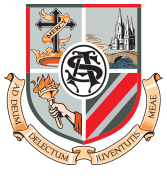This year again was a remarkable year for St. Aloysius at the Young Scientist Competition. Five projects were accepted for the competition. The projects were entitled:
1. How fresh are your eggs?
2. Reverse engineering a domino fall
3. The lute of Pythagoras
4. Facial recognition and the cross race effect
5. The Gabor limit.
Of these projects, the Gabor limit obtained a highly commended award. Particular congratulations to the 3 Transitions year students involved in this project.
There was a huge commitment by all 12 students who participated in the competition and well done for the commitment that they have shown. They represented St. Aloysius school admirably.
1. Wind vs. Stringed Instruments and the Gabor Limit
This project investigated the variation in musicians who play stringed and wind instruments in beating the Gabor limit. The Gabor limit is a relation linking frequency and time and is given by ΔtΔf=1/(4π). It essentially tells the minimum time between two notes being played and the ability of the human ear to distinguish between these two notes. Serena Foley, Susan Lagli and Aleksandra Migliaccio, transition year students completed this project and were awarded highly commended.
2. How fresh are your eggs?
A group of 1st year students: Benushila Tripathi, Samiksha Paudel and Amy Fitxgerald investigated this project. They measured the mass of eggs kept in the frige and at room temperature. They found that the eggs lost considerably less mass when kept in the fridge and concluded that eggs remain fresher when kept in the fridge as opposed to at room temperature.
3. Reverse Engineering a Domino Fall:
Molly Young and Shauna Williams (5th Years) modelled how much energy was required to lift a set of dominos from a fallen position. They used calculations involving the centre of gravity, energy conversions and acceleration.
4. Facial recognition and the Cross Race Effect:
This was a project entered into the Intermediate Social and Behavioural section. Amber Harrington and Laura Coleman investigated the ability of people from different races to recognise faces from other races relative to their own.
5. A mathematical analysis of the lute of Pythagoras:
The lute of Pythagoras is a geometric shape made of pentagons with inscribed pentagrams. Maria Cordero and Aisling O’Sullivan measured and assessed the ratios and proportions of the shape, the fractals it produced and the ensuing golden triangles. They then aligned the lute to renowned works of art to show the correspondence between the beauty of nature and mathematics and showed that the lute is an ideal tool for drawing perspective due to its exceptional aesthetics.









